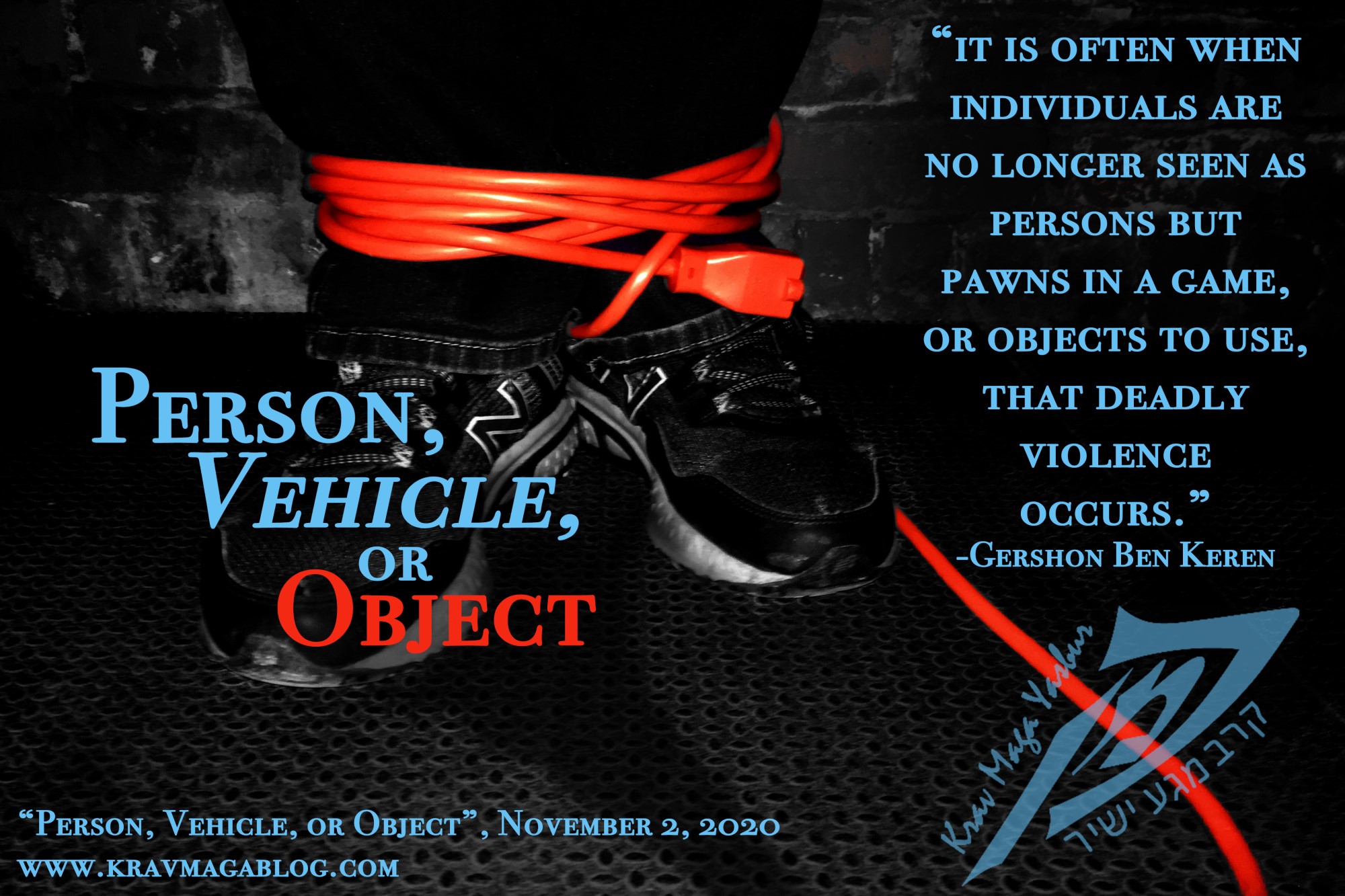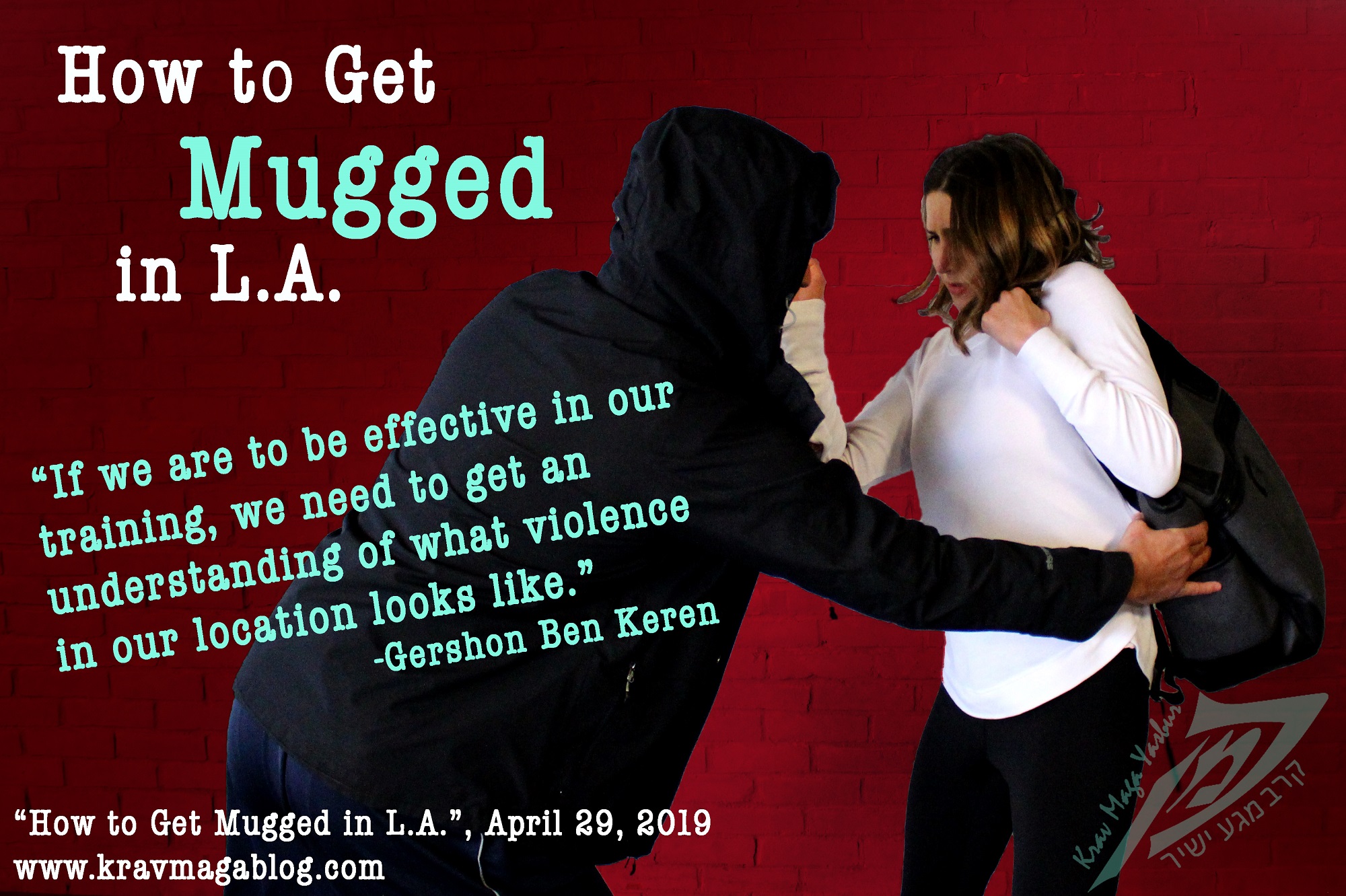How To Get Mugged in LA, is an article written by Gershon Ben Keren, a 5th Degree Black Belt in Krav Maga, who teaches Krav Maga in Boston, MA. He has also authored three Amazon best-Selling Books on Krav Maga.
It’s very easy to talk about muggings and robberies as if they are a universally similar phenomenon across all locales e.g. the way a mugging is conducted in New York, is the same as the way it’s committed in Chicago, etc. However, although there may be many similarities, there may also be distinct and important differences. Sometimes as instructors and/or students of violence, we fall into the trap of creating training scenarios that reflect our ideas about what a mugging/street robbery looks like, rather than what actually occurs. Sometimes this is based on the experiences of those we know who have been mugged and/or media reports of muggings, etc., and so it seems that the training scenarios we use to replicate these incidents reflect “reality”, however the sample sizes we are using may be too small to adequately do so. In this article I want to compare the “typical” anatomy of a robbery/mugging in Los Angeles to one in Boston, to identify similarities and differences, and get a better idea of what a mugging looks like. Both cities make their crime incident reports public, so the data is available to analyze; L.A. has done so for the past ten years, and Boston for the past three. There are a few differences in reporting methods and codes, so I have restricted the location of robberies to public spaces e.g. streets, parks, garages, etc., and have excluded those that take place in schools, private buildings, and commercial spaces, etc.
If we look at weapon use in muggings, a large percentage of Boston muggings (64%), involve “strong arm” tactics, where no weapon is used, compared to 54% for L.A., i.e. there is a greater chance of a weapon being used in L.A. than in Boston, however for both cities most muggings don’t involve an active weapon, and compliance is gained through intimidation, the threats of violence, and/or unarmed physical force. In Boston, 19% of “strong arm” muggings use actual physical force, rather than just the threat of violence; whereas in L.A., when strong arm tactics are used less than 4% involve physical contact. The L.A. incident data also includes certain victim characteristics, such as gender and age. When we look at the use of strong arm tactics by gender, we can see that 71% of all robberies that target women employ this tactic, as compared to 47% for those that target men i.e. when a man is mugged - in L.A. - it is much more likely that a weapon will be used. The L.A. data is also much more detailed in the types of weapons used than the Boston data, and goes into quite specific detail e.g. in one robbery a bow and arrow was used as the weapon of choice. If weapon types are categorized e.g. scissors, and machetes are classed as “Bladed Weapons” for example, we can make a comparison with the Boston data. In Boston, firearms were used in 14% of all muggings/robberies whereas in L.A., guns – both long and short barrel – were used in 26%. In 12% of all robberies in Boston, some form of bladed weapon was used, as compared with L.A.’s 11%. What the data shows us is that there isn’t just one common template for a mugging, and for us to train effectively, we must create scenarios that reflect these variations. Although we don’t have victim data available for Boston, there is reason to believe that strong arm tactics are more prevalent in robberies that target women than men, just like in L.A. If we are to truly teach and practice reality-based self-defense, we need to reflect these realities (we can of course exclude training defenses against bows and arrows, as this one incident should be seen as a statistical outlier).
It should also be noted that based on the L.A. data, men are much more likely to be the victim of a mugging than women – men make up approximately 70% of all robbery targets and women, only 30%. From my conversations with many women who’ve attended our women’s self-defense program over the years, this appears to be a common misconception - with many believing that most muggings will target women. Without interviewing every mugger and asking them why the prefer male rather than female victims, we are only speculating – and there could be any number of reasons for this. It could be part of a loose, undefined criminal code that some muggers have, believing that men are fair game, and are physically able to “defend” themselves whereas women are not, and therefore it would be wrong to target them, etc. It could also be down to the secondary motivations which are present in violent crimes. The primary motivation and goal of a “street” robbery is to get cash, however there are also secondary motivations at play e.g. there are reasons why some criminals choose to burgle houses, why others pick pockets and why others use physical force – or the threat of it – to acquire and deprive others of their resources. In a robbery, the mugger gets to exert power and control over their target/victim and dispense some of their anger. It may not be so rewarding or satisfying to feel power and control over a woman who they believe is physically unable to match them, versus a man. Another factor that may affect gender choice is victim opportunity and availability – it may simply be that in certain locations, and at certain times, there are more potential male targets/opportunities than female ones e.g. more single males who look cash rich than female ones, etc. Again, this is speculation. It may also be a combination of all these factors – and others - that is responsible for this dramatic gender skew.
Boston and L.A. are two very different cities environmentally e.g. L.A. is laid out on a neat grid, whereas Boston’s street layout is less organized. When mapping the locations where street robberies take place (and these account for 86% of locations, with a further 9% being committed in parking lots, and the remaining 5% in various public spaces, such as parks and open areas). In L.A. the hotspots and crime clusters follow major roads and route ways, in a north/south fashion, with 69% of incidents occurring on cross-streets, which offer multiple routes of escape – alleys, underpasses and overpasses which have limited escape routes only account for 4% of all street locations. This demonstrates that muggers primarily work in heavily trafficked areas, with multiple escape routes, rather than in remote locations i.e. they go where there is a rich and constant supply of potential victims. Another interesting difference between the two cities, is that Boston has very definite peaks and troughs, concerning the time of day when muggings occur, and variations between week days, in a way that L.A. does not. In L.A., time of day for weekdays is pretty much consistent across days, with a steady climb of incidents throughout the day starting at 8-9 AM, with a spike at 3 pm, and then another steady rise to 8-9 pm before falling away. However, Boston sees much greater variations between weekdays, with muggings on Tuesdays peaking between 6pm and 7pm, whilst on Tuesdays, it’s between 9 and 10 pm, and on Wednesdays between 10pm and 11 pm. This reflects a city with a much more defined ebb and flow of its citizens. With a larger population, the individual lifestyles and habits of L.A.’s citizens are going to make victim availability more uniform.
By taking a look at crime incident reports between different cities, we can see that there isn’t just one template for robberies in public spaces. By looking at victim profiles, such as age, it is possible to see that men aged under 30, are most at risk, and as victims age, their risk declines proportionately – this is probably due to lifestyle changes that see older men less likely to be in the locations, at the times, where such incidents occur. All of this helps us get a better picture and understanding of what real world violence looks like, and how it also differs by locale. If we are to be effective in our training, we need to get an understanding of what violence in our location looks like. As a Krav Maga instructor teaching an Israeli system, that was developed to meet the safety needs of those in Israel, I have to understand how things might need to be adapted for my students in Boston, rather than blindly teach solutions that were intended to deal with different problems.
0 COMMENTS















